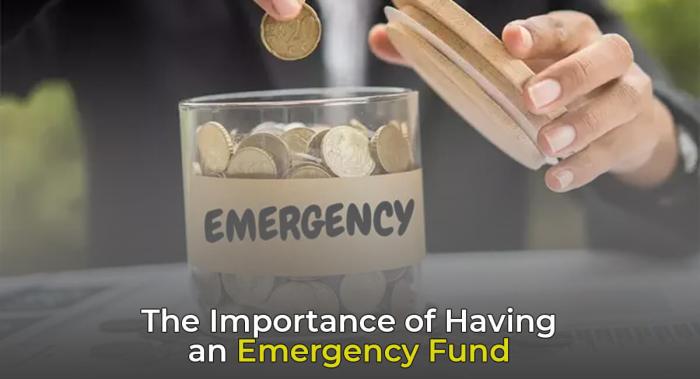Hey there, are you ready to dive into the world of emergency funds? Buckle up as we explore the ins and outs of why having an emergency fund is crucial in today’s unpredictable world.
Let’s break down the basics and get you up to speed on everything you need to know.
What is an emergency fund?

An emergency fund is a stash of money set aside to cover unexpected financial emergencies or expenses that may arise. Its primary purpose is to provide a financial safety net in times of need, allowing individuals to handle unforeseen circumstances without going into debt or compromising their financial stability.
Importance of having an emergency fund
Having an emergency fund is crucial for several reasons:
- It helps to cover unexpected medical expenses, such as sudden illness or injury, that may not be fully covered by insurance.
- It provides a buffer for unforeseen home or car repairs, preventing the need to take out high-interest loans or put expenses on credit cards.
- It offers peace of mind during times of financial uncertainty, such as job loss or economic downturns, by ensuring that basic needs can still be met.
How to build an emergency fund?
Building an emergency fund is crucial for financial stability and peace of mind. It serves as a safety net for unexpected expenses, such as medical emergencies, car repairs, or sudden job loss.
Strategies for saving money to build an emergency fund
- Set a realistic savings goal: Determine how much you want to save for your emergency fund. Start small if needed and gradually increase the amount over time.
- Create a budget: Track your expenses and identify areas where you can cut back to save more money. Allocate a portion of your income specifically for your emergency fund.
- Avoid impulsive purchases: Think twice before making non-essential purchases. Prioritize saving for your emergency fund over unnecessary items.
- Automate your savings: Set up automatic transfers from your checking account to your emergency fund to ensure consistent contributions without having to think about it.
Recommended amount to have in an emergency fund
Financial experts recommend saving at least three to six months’ worth of living expenses in your emergency fund. This amount can vary based on individual circumstances, such as income stability and family size.
Tips on making contributions to an emergency fund regularly
- Make it a priority: Treat your emergency fund savings like a bill that must be paid each month. Set a specific amount to save regularly and stick to it.
- Use windfalls wisely: If you receive unexpected money, such as a bonus or tax refund, consider allocating a portion of it to your emergency fund to boost your savings.
- Reassess and adjust: Regularly review your budget and savings goals to ensure you are on track. Make adjustments as needed to accommodate changes in your financial situation.
Importance of liquidity in an emergency fund.
When it comes to an emergency fund, liquidity is key. Having liquid assets means you can quickly access cash in case of unexpected expenses or financial emergencies. This immediate access to funds can make all the difference when you are faced with a crisis.
Difference between liquid and non-liquid assets
- Liquid assets: These are assets that can be easily converted into cash without losing much value. Examples include savings accounts, checking accounts, and money market accounts.
- Non-liquid assets: These are assets that may take time to sell or convert into cash, and doing so could result in a loss of value. Examples include real estate, jewelry, and collectibles.
Examples of liquid assets suitable for an emergency fund
- Savings account: A savings account is a common choice for an emergency fund due to its accessibility and low risk.
- Money market account: Similar to a savings account but typically offers higher interest rates, making it a good option for emergency funds.
- Certificate of Deposit (CD): While not as liquid as other options, CDs can still be used for an emergency fund if you opt for shorter-term CDs with lower penalties for early withdrawal.
Emergency fund vs. investments.
When it comes to financial planning, it’s essential to understand the differences between an emergency fund and investments. While both serve important purposes in securing your financial future, they have distinct roles and functions.
An emergency fund is a stash of money set aside to cover unexpected expenses or financial emergencies, such as medical bills, car repairs, or sudden job loss. It acts as a safety net to protect you from going into debt or having to liquidate assets during challenging times.
On the other hand, investments are assets purchased with the expectation of generating income or appreciation over time. These can include stocks, bonds, real estate, or mutual funds. Investments are typically intended for long-term growth and wealth accumulation.
Why keep emergency fund separate from investments?
Having a dedicated emergency fund separate from your investments is crucial for several reasons. Firstly, emergencies can happen at any time, and you need quick access to cash without worrying about market fluctuations or selling investments at a loss.
Secondly, investments come with varying degrees of risk. While they have the potential for higher returns, they also carry the risk of losing value, especially in volatile markets. Using investments as an emergency fund exposes you to the possibility of having to sell assets at a disadvantageous time, potentially eroding your long-term financial goals.
Lastly, an emergency fund provides peace of mind and financial security. Knowing that you have a readily available fund to cover unexpected expenses allows you to weather financial storms without derailing your overall investment strategy.
It’s wise to keep your emergency fund in liquid, low-risk accounts, such as a high-yield savings account or a money market fund, separate from your long-term investment portfolio.
